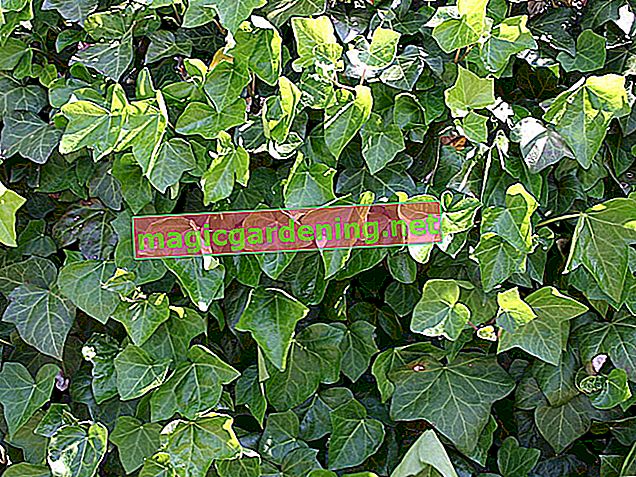
Can ivy also be kept as a houseplant?
Ivy can be planted not only in the garden, but also in the tub. You can even plant it in flower boxes. You can even care for ivy as a bonsai.
also read
- The right location for ivy in the garden or room
- Planting and caring for ivy in the garden
- Remove ivy from the garden as a ground cover
Which location is suitable for ivy?
- shady
- partially shaded
- no direct midday sun
- in the bucket like north balconies
Ivy likes it shady, but can also cope with partially shaded locations. Strong midday sun should be avoided. Varieties with variegated leaves only develop their colors if they get some sun every day.
A place in the flower window is possible all year round as a houseplant. However, the plant should be protected from direct sunlight, especially at noon.
Which substrate prefers ivy?
Ivy does not make great demands on the earth. Simple garden soil, which you can add some compost to before planting, is sufficient.
The substrate should be able to hold moisture well. Waterlogging is to be avoided at all costs.
When is the best time to plant?
Ivy is best planted in spring or autumn. In principle, you can plant the climbing plant at any time, as long as it doesn't freeze. In summer, you need to take care that the soil does not dry out and water it frequently.
Which plant spacing should be kept?
When planting as a ground cover or privacy screen, keep a planting distance of about 25 centimeters.
Maintain sufficient distance from walls, fences and neighboring properties so that the plant does not become a nuisance. Masonry can be damaged by the adhesive roots. Old ivy plants can cause trees to die.
How is ivy planted?
If you bought ivy in a pot, dig a planting hole of the appropriate size. If the plants are home grown, put them in the soil so that the roots are well covered.
Keep the soil moist, but avoid waterlogging.
In the first winter, light winter protection makes sense. Create a mulch blanket or cover the ivy with pine branches.
Can ivy be transplanted?
Repotting ivy does not make sense. If you want to green other areas in the garden, you should rather pull cuttings. In the old form, ivy forms very pronounced roots that cannot be dug up without damage.
How is ivy propagated?
Propagation takes place via cuttings, which you should cut in spring if possible. If you cut shoots of young plants for propagation, you will get offshoots that also tendrils. If you use shoots of the age form, the resulting plants will turn into upright bushes.
The cuttings are either put in prepared pots or placed in a glass with water until they form new roots.
Another way to propagate ivy is through sinkers. Shoots are bent to the ground and covered with earth.
When is the flowering time of ivy?
Ivy is in bloom in autumn. That is why ivy is a very valuable plant for the ecological garden. It is an important source of nutrition for bees, wasps and other insects during flowering.
The fruits are ripe at the beginning of the following year.
What does age form mean in ivy?
For the first ten years, ivy is a climbing plant that forms long tendrils. During this time, no flowers or fruits form. The ivy receives its age form after the tenth year. Then the leaves change and the plant grows upright.
Does ivy get along with other plants?
Ivy gets along with plants that also prefer a slightly moist and shady location. However, there is a risk that neighboring plants will become overgrown. This also applies to trees on which the ivy climbs.
Is ivy poisonous?
Ivy is poisonous in all parts of the plant. The leaves and stems contain substances that can cause inflammation on contact with the skin.
Fruits and flowers are particularly poisonous, but only occur in the age form. If children or pets such as cats and dogs consume the fruit, there is a serious risk of poisoning.
In homeopathy, ivy is used for bronchitis and other respiratory diseases. Only the leaves are used for this. Furthermore, extracts are processed into shampoos and other personal care products.
How hardy is ivy?
The common ivy (Hedera helix) is absolutely hardy. Species with variegated foliage tolerate frost temperatures less well. You should therefore cultivate these varieties in the tub on the balcony or as a houseplant.
Tips
In the first two years, the growth of ivy is still limited. In the following years, however, the climbing plant can spread rapidly. Regular trimming and thinning is therefore essential.
 Ivy 6.85 EUR Buy at baldur
Ivy 6.85 EUR Buy at baldur  Ivy 'White Ripple' 7.84 EUR Buy at baldur Hardy
Ivy 'White Ripple' 7.84 EUR Buy at baldur Hardy  ivy 'Baltica' 10.74 EUR Buy at baldur
ivy 'Baltica' 10.74 EUR Buy at baldur








